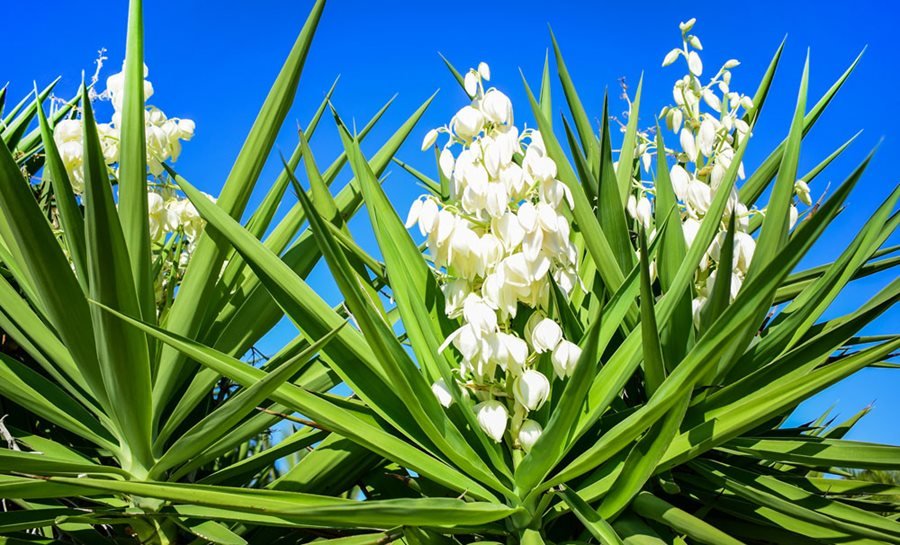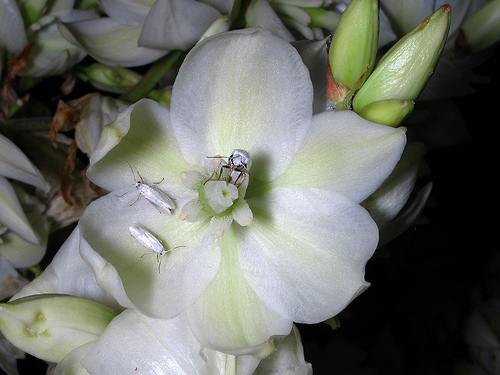February: Yucca (Yucca filamentosa)
 The plant chosen for this month highlights cultural appreciation, as February celebrates African American/Black History Month. The Yucca plant (Yucca filamentosa) is a native, perennial plant common to regions of the Caribbean and eastern North America. Yucca plants are known for their distinctive spiky, dagger-like leaves in a variety of sizes and colors. Yucca belongs to the Asparagus Family (Asparagaceae), and is further classified under the Agave Subfamily (Agavoideae).
The plant chosen for this month highlights cultural appreciation, as February celebrates African American/Black History Month. The Yucca plant (Yucca filamentosa) is a native, perennial plant common to regions of the Caribbean and eastern North America. Yucca plants are known for their distinctive spiky, dagger-like leaves in a variety of sizes and colors. Yucca belongs to the Asparagus Family (Asparagaceae), and is further classified under the Agave Subfamily (Agavoideae).

Yucca bloom. Image from Monticello.org
Yucca (Yucca filamentosa) and other plants of the Agave subfamily are generally identifiable based on the following plant characteristics:
1) Stiff, sword-like leaves with variations in leaf form sizes and colors
2) When flowering, produces large spikes of hanging, bell-shaped flowers
3) Only pollinated by a particular type of moth, forms a mutualistic relationship between the Yucca plant and the yucca moth (Tegeticulla yuccasella).

Yucca moths on a Yucca flower (photo by Alan Cressler, used with permission)
It is important to note that Yucca can be easily confused with “yuca”, a common name (particularly in Spanish) for cassava or manioc. This demonstrates the problem of using common rather than scientific names: Yuca, or cassava/manioc root, is edible, while the roots of the Yucca plant may cause intestinal distress if consumed!

A group of several yucca plants in nature.
Yucca has primarily been used for decorative purposes, and historically is associated with African and African American communities. The stiff, abrasive leaves of the Yucca plant were used to “ward off evil spirits”: groupings of Yucca leaves were tied above doorways to protect homes, and were planted as boundary markers around properties. They were also planted as grave markers in African American cemeteries. These practices may have been rooted in West African spiritual beliefs.
Yucca also has other uses. At Thomas Jefferson’s Monticello, where Yucca is listed in Jefferson’s Garden Book, the leaves of Yucca were processed into rope similar to a hemp plant and used to stake and tie up grapevines. Historically, the Cherokee Indians used the pounded root as a soap, taking advantage of saponins in the plant. They also spread the pounded roots in water to “intoxicate fish” (further pointing to the inedibility of the roots!). Both the Cherokees and the Catawba Indians used the root to treat skin ailments, and the Cherokees used an infusion of the Yucca plant to treat diabetes.

Yucca filamentosa in a raised plant bed.
Yucca plants are also historically used as landscaping around property boundaries and can still be seen used in horticultural practices today. They are one of the plants that archaeologists keep an eye out for while surveying, as living-heirloom indicators of historic homesteads and cemeteries that no longer have above-ground remnants.
References Cited:
- The Committee for the Restoration and Beautification of Randolph Cemetery (2010) Cultural Customs. Historic Randolph Cemetery. Electronic document, accessed 15 February 2021.
- Bruner, David (1998) Hidden Power: Burial Practices from an African-American Slave and Tenant Community. Levi Jordan Plantation, Brazoria, Texas. Electronic document, accessed 15 February 2021.
- Hatch, Peter (2010) A Rich Spot on Earth: Thomas Jefferson’s Revolutionary Garden at Monticello. Yale University Press, New Haven, Connecticut.
- Moerman, Daniel (2004) Native American Ethnobotany Database. Electronic document, accessed 15 February 2021.
Sources and more information over Yucca and other varieties:
Elpel, Thomas J. (2018) Botany in a Day: The Patterns Method of Plant Identification 6th ed. HOPS Press, Pony, Montana.
Fernald, Merritt, and Alfred Kinsey (1943) Edible Wild Plants of Eastern North America. Harper & Row, New York City, New York.
Lady Bird Johnson Wildflower Center (2021) Plant Database: Yucca filamentosa Texas A&M University Extension. Electronic document, accessed 15 February 2021.
Lady Bird Johnson Wildflower Center (2021) Ask Mr. Smarty Plants: Toxicity of Yucca leaves. Texas A&M University Extension. Electronic document, accessed 15 February 2021.